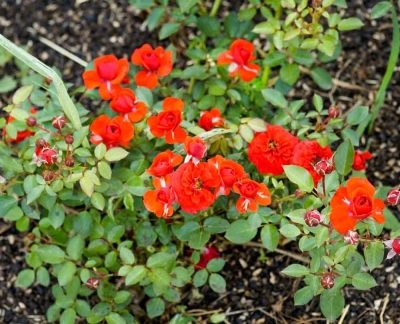
- Name synonyms: Baby Baccara
- Group: miniature (dwarf, border)
- The main color of the flower: red
- Flower shape: cupped
- Diameter, cm: 5-6
- Flower type by number of petals: thick double
- Description of the bush: compact, thick
- Bush height, cm: 35-40
- Stud size: medium
- Leaf size: small
You can decorate a small flower bed with roses in the yard or enjoy the pots of beautiful flowers on the terrace by creating all this with your own hands. To do this, you need to choose the right pink varieties for planting, which bloom profusely and do not require complex agricultural techniques. These include French-bred Baby Baccarat roses.
Breeding history of the variety
Baby Baccarat is a striking representative of miniature varieties, bred by French breeders in 2005. The authorship of the culture belongs to Meilland. The variety is suitable for cultivation in the Central region of the country, as well as in its southern part. For growing in Siberia and the Urals, the culture lacks frost resistance.
Description of the variety
The French miniature rose is a compact bush that grows to a height of 35-40 cm. The plant is characterized by abundant branching, moderate thickening of small foliage of a dark green color with a pronounced gloss, weak spikes of shoots and a developed root system. Due to the rapid formation and growth of lateral shoots, the rose bush looks very magnificent - up to 30-35 cm in diameter. On the stem, from 3 to 5 flowers are formed, located both singly and in inflorescences.
Advantages and disadvantages
Baby Baccarat is characterized by many advantages, among which are abundant and long flowering, good cold resistance (the plant can withstand temperatures down to -23), average immunity that can protect against fungal infections, the incredible beauty of flowers during mass flowering.
Disadvantages include low intensity of aroma and moderate resistance to rain, in which some of the buds may not open.
Flowering features
Roses bloom profusely, 5-7 flowers at a time, so the bush is always bright and incredibly beautiful. The flowering period is long - from mid-June to October. On the stems, goblet buds of red-orange color are formed.
Dissolving, they turn into dense double cups-shaped roses. Each rose consists of 50-55 velvety petals, tightly adjacent to each other. The color of the flower is rich - bright red or scarlet. Despite the compactness of the bush, the roses are medium-sized - 5-6 cm in diameter. The aroma of the flowers is light, but very pleasant.
Use in landscape design
This variety is ideal for zoning flower beds, decorative decoration of curbs, lawns and paths. In addition, roses are massively grown in pots, decorating courtyards, balconies, window sills, and gazebos. French roses go well with other flowers and plants, which is why landscape designers are very fond of them.
Landing
Planting is carried out both in spring and autumn. The spring planting of roses is carried out from late March to mid-May, and the autumn planting in October, a month before the onset of stable frosts. For planting rose bushes, an area is selected where there is enough light, heat and sun, and there is also a protective barrier against drafts.
The plant is most comfortable to grow in nutritious, fertile, light, breathable, drained and non-acidic soils. As a rule, it is a light loam that allows air and moisture to pass through well.It is important that the passage of groundwater is deep, since the roots of the rose are long enough, buried in the soil.
Growing and care
A rose is grown with the help of seedlings, the roots of which are pretreated with a growth stimulant. For planting, an average depth of a hole is made, where drainage and fertilizers are laid. The seedling is deepened so that the grafting site is 3-5 cm above the soil. The planting process is completed with abundant watering with warm water and compaction of the soil. Plants are arranged tightly - 5-6 units per 1 m2.
Rose care is standard: watering, fertilizing, loosening and weeding the soil, sanitary pruning of bushes, disease prevention, shelter for the winter.
Watering and feeding
Roses need regular watering (every week). In dry summers, it is recommended to double watering. Roses are fed several times during the season. In early spring, the plant needs ammonium nitrate or urea. During the flowering period, roses need phosphorus-potassium fertilizers.
Pruning
During the growing season, the bushes need sanitary pruning, shortening of shoots and light thinning.
Frost resistance and preparation for winter
Warm pink plantings for the winter in regions where winters are harsh and little snow. Shelter with burlap is carried out when the temperature drops to -7 degrees.
Diseases and pests
Thanks to their immunity, roses are protected from many infections. The variety has medium resistance to powdery mildew and black spot. Sometimes the bushes attack aphids and spider mites.































































